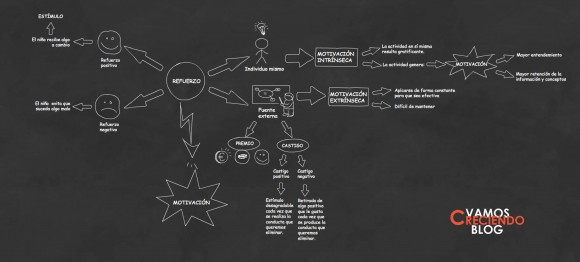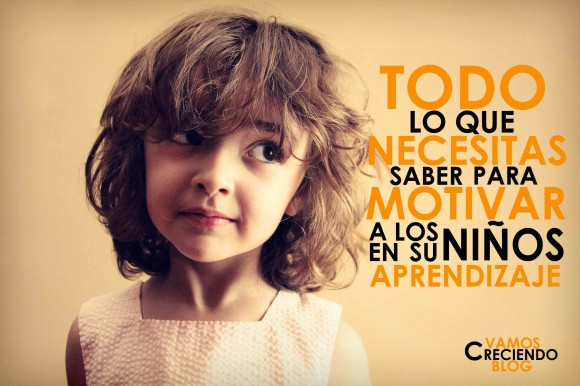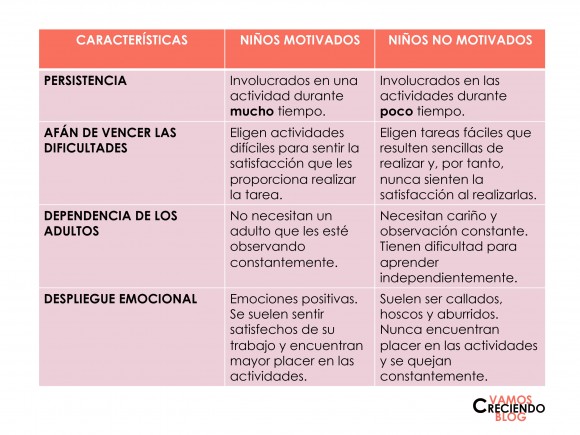The motivation It is a vast subject and has been treated from many perspectives. Many theorists talk about the importance of this learning but there are also those who claim that motivation is not at all representative of the individual learning.
I personally feel that it is extremely important, not only from a theoretical perspective, but from a completely practical perspective, and I have observed firsthand as is the evolution of those motivated students and as is those who are not.
In this post we will see a short summary of the main points related to motivation in young children, the main types of motivation, how can we know through the behavior if we are motivated to children or not and how we can develop motivation.
We start?
First, okay let's start with a definition the term we're trying. Among many other definitions, we can say that motivation is a process by which behavior and activity of an individual, They start and continue.
For children, we all know that they have an innate need to learn, And how this learning occurs? For through their interactions with the environment.
The pleasure that the child is in these interactions encourages you to continue interacting. The fact of finding pleasure when interacting with the environment is a skill and is the basis for motivation. So it is said that children are born with much intrinsic motivation, (do not worry we now see what is), because at birth they are totally biased and "motivated" to make this interaction.
What we as educators we must ensure is that they do not lose this motivation, stimulate and guide it as far as possible through patterns Early Learning to pave the way for lifelong learning.
I have prepared the following scheme for, take a look, you may see the main methods of motivation and attempt to change behavior. Of course, you know that if something is not clear or what you'll agree not only have to tell me.
 Once we have laid the foundation of the term, I think it is interesting to see how it develops motivation in children born from these.
Once we have laid the foundation of the term, I think it is interesting to see how it develops motivation in children born from these.
As we have said above, the babies, born with a lot of intrinsic motivation, this is intended to achieve any visible effect on the environment. In the small child, Attempts to control the environment in which it is usually limited to mourn, vocalizar, make small movements and facial expressions, therefore, the toys or make sounds change when the child moves are strong motivators.
When the baby is 9 and 24 months, begins to make more possible voluntary movements with a purpose that is none other than greater control of the medium. This greater control allows children to feel successful and success in turn means greater self-esteem accompanied by feelings of self-worth that lead to motivation.
As children are developing and growing, They are better able to make decisions and plan what to do to control their environment by setting goals.
When we talk of success we must consider that the Success is not equal to the standards set by adults, Success is achieving the goals set at own children. So I always tell my parents they should ask their children if they feel they have worked well, if they have performed well, etc. Because they know perfectly if they have "achieved success" or not. It is great that let them reflect on this and not that we are what we adults give them all done.
When children already have around 2 years old, most make a sequence of actions to achieve a goal and, further, begins to evaluate the quality of their efforts.
To reach 3 years old, interested in reaching a achieving excellence, rather than simply achieving a goal. They usually have an idea of the various levels of competition to achieve a goal and realize that success is based on quality established by its own internal standards.
between the 3 and the 5 years old, normally, They start using oral communication to control their own behavior during a troubleshooting situation, this basically means that talk to themselves, as they grow something that will turn into a "conversation" internal. This ability to control problems is the basis of motivation at this time. During this phase the confidence to know that you can solve problems motivates you to accept new situations and problems and this is a higher learning.
Having said this, and having located the stage where each of your children or students is, we will see what features in the behavior of the kids you can see for detecting the state of their motivation.
I have prepared the following table so you can see the comparison between the behavior of those motivated children and those who are not.
Therefore, so far we have seen: the types of motivation, the features in the behavior of children that can help us to know what the "state" of their motivation and the phases that go from birth. Once you are seen that, How can we help children develop skills of motivation?
As already we discussed, in principle, young children should not let them lack an external or extrinsic motivation, because intrinsic motivation is very high unless not been stimulated.
In fact, the problem of using extrinsic motivation with young children is that they usually receive something every time you perform an action, therefore, we can say that the ideal state is to keep intrinsically motivated, although obviously all, I first, We use extrinsic motivation to encourage children.
In any case, and whereas our goal is to achieve the "ideal state", we will see how can we encourage children to continue their intrinsic motivation.
- Environment. It's great that allow them to explore their environment freely and see the effects of their actions. An example of this are the toys that sound and change state.
- Time. It is important to give enough time when they work, keeping in mind their persistence. Further, when the kids are involved in an activity we must ensure that end without interruptions.
- Response to their needs. We must help but always trying to be as independent as possible.
- Children + Adults. This means that we must promote joint exploration situations. Further, we can use to introduce young models and explain through action.
- Difficulty acceptable. We should note that the difficulty of the activities they propose is acceptable and always according to their age.
- Achievements. It is good that we allow children to assess their own achievements. As we have seen, instead of telling us we can ask them to tell us they are saying and how they see it.
- Beware of rewards! It is not good that we use excessive rewards. Praise and rewards should be based on their effort and persistence, instead of achieving the same.
As I said above, the aim of these guidelines is to achieve the ideal state, but obviously it is difficult and it is normal, sometimes, We resort to other forms of rewards and motivation in order to encourage the kids. What we must remember is that if we want to motivate children with rewards just never achieve our goal and be effective for some time but without impact on their future.
To finish, I would like to say that I have tried to summarize in this post what I think, from my point of view, It is most important on this topic, or at least, the most useful for you, but you must keep in mind that this is an extensive topic.
Therefore, if you are interested and want to see it in greater depth, Some learning models involving a theory of motivation are the Maerh and Meyer, 1997; Jesus Alonso Tapia, 1997, of that in the coming days I will hang in the download area, a pdf with the guidelines that we can do to encourage children, almost all, So if, focused on classroom action. I have prepared this document because it seemed too for inclusion in the post. By last, another author who has dealt with this issue is Walberg, 1981.
As a curiosity, os animo a que consultéis a Clark Hull, who he developed a formula to determine the motivation.
Of course, have many more authors throughout history they have dealt with this issue, but I leave these references as they are of the latest.
As usual, Thank you for taking your time.
Kisses to all.
The only limit to our success tomorrow is our doubts of today.
Franklin D. Roosevelt
Tags: Babies, Achievement, Meta, Learning models, Motivation, Motivación extrinsic, Intrinsic motivation, Motivate, Children, Motivation theory




 Español
Español English
English Français
Français Deutsch
Deutsch 中文(简体)
中文(简体) Português
Português

Hello!
When working with my students the seriaciones, They are often mislead, I did not serve well in the classroom, and finally do not capture well the concept. Could I give some advice to motivate them with some good activity?
Thank you very much in advance.
Your PD scheme motivation is very enlightening, I love!!! 😉
Hi carmen,
First, Thanks for your comment and participation.
For the sin of them they tend to be complicated seriaciones, it is difficult to understand what the first, why not pay too much attention, They will mislead and discourage.
A good way to get their attention is with significant learning, that is to say, activity involving them, because we can not expect a child 4 Look out for years 10 minutes while explaining Book Series, but yes, if you get involved and it manipulates.
If for example you are working a number of colors, takes strollers or any other toy you have available and explain it with the elements themselves, places you the first to understand that it is a number and ask him to place the following. Once you have the complete series ask the Review aloud: “Two blue, red one, two blue, red one…”
Another activity that I do with my students is, during the assembly, give each child a piece of chalk and ask them to draw the series in the ground. This love, so you're calling your attention and you keep them motivated. You can also work with the series in the table plati.
I hope these ideas will serve and the next time you work with your students series let them “speechless”
A hug,
Cristina
Tomo nota! Thank you!!!!
Thank you Carmen!!
I hope you find it useful.
A hug
Congratulations, my kids are older and I have grandchildren, but I follow thanks to a friend who has given me your blog.
Beautiful and useful educational texts.
Hi Marga,
What I say I…! It is always good to read about education although we are not directly related to it. It is the basis of our society and we should be aware of as it is made to “owners of our tomorrow”.
I send you a big kiss and hope you keep finding interesting information on the blog.
Cristina
I HAVE A CHILD 5 YEARS, LEARNING WITH THIS strokes of the letters and numbers, WHEN YOU FRAME WORK, Lost quickly interest in these, HOW DO YOU FOR THE TASKS THAT BECOME FRAME GAMES AND SO CAN LEARN TO THE STROKES…THANK YOU VERY MUCH AND BEST REGARDS.
Hi Lizbeth,
First, Thank you very much for participating in the blog!! 😀
Tasks that you prepare to learn the strokes is pace you for your review with the small pencil, then, es normal que se aburra.
As I said in the post “The game. Key learning of the smallest”, play at this age should be learning itself. In this way we will be generating significant learning in small. Note that what we experience directly be remembered much more than what just read or hear.
To answer your question, some of the things you can do to practice with little directionality of the letters are as follows: rather than pace you, and they have to go over with the pencil, play your stroke with finger paint, thus you are experiencing the stroke with his own body and, well find it a much more attractive by keeping their attention activity, you get it fits better. Finger paint with tempera or you can make changes as making brush strokes or even with ear buds, This is very good idea because they do not catch as much paint and brushes, therefore, the kids the best control.
Besides this, another way is to practice the strokes on a surface marking, how? You put on a tray a little flour, and you play to carrying out the different letters and numbers. You can also do it on the sand park.
If you have a small blackboard, This is also a way to practice the letters to the kids usually love it. You can pretend that he is the teacher, and you have to teach you where we started the stroke, where we ended, the path of the letter, etc.
Also do not forget that for such work concepts have many multimedia games, both tablet to the computer.
Y, of course, I encourage you to make the letters juguéis with your own body, this is a great way to practice and have a good time.
In December, I tried this in the post "The tricks you need to help your child learn the numbers and the letters". Although I think I've summarized a little all, I encourage you to read it if you can find something more useful to you.
I hope this information will serve you and would love you to tell me the result 😀
A big kiss,
Cristina
Good way to describe and analyze this topic. I have been looking for more information online and this product is
the best I've found, Thank you for sharing that.
🙂
Thank you Marina!
I hope you continue finding useful information.
A hug